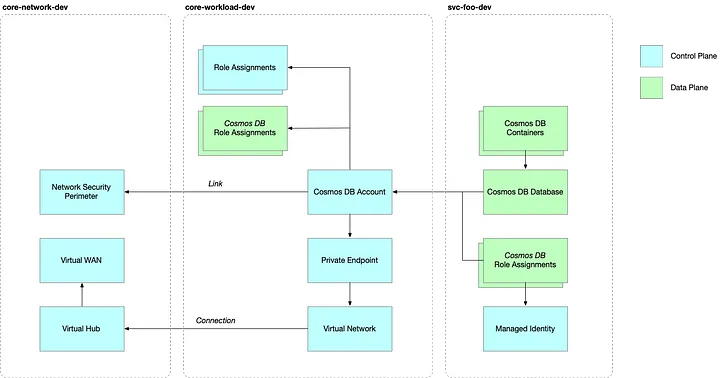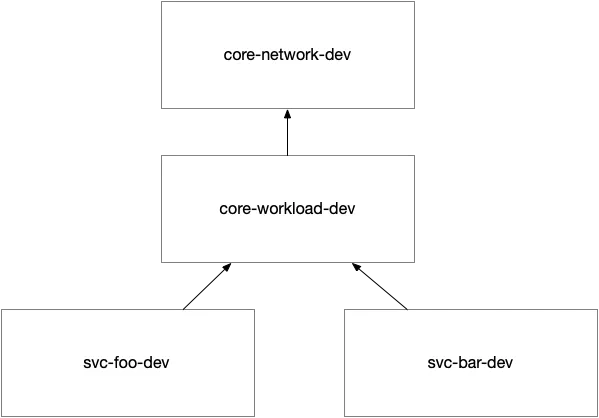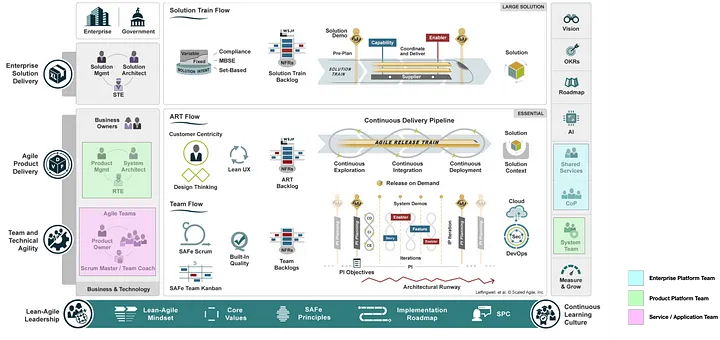Scaling Infrastructure-as-Code in the Enterprise: Aligning your Organization for Success
A well-structured Infrastructure-as-Code (IaC) strategy is critical for ensuring clear ownership, governance, and accountability across a large-scale enterprise with multiple teams. In an organization with a large program team of 100+ people, distributed across many teams and operating within a broader enterprise ecosystem, managing infrastructure efficiently requires careful coordination at multiple levels. Each layer of the organization plays a distinct role in defining, provisioning, and maintaining infrastructure in alignment with business, security, and operational objectives.
At the highest level, the enterprise governs overarching policies and standards, while program-level teams provide enablement through shared services and infrastructure platforms. Individual service and application teams, in turn, build and maintain their own environments while ensuring alignment with enterprise guidelines. Understanding these roles and the interactions between them is crucial for maintaining stability, security, and efficiency in large-scale IT delivery.
Hierarchical Terraform Module Organization and Dependency Management
To illustrate how Terraform modules are structured and interdependent, the following diagram provides an overview of how shared infrastructure components are managed at different levels.
 Above is a diagram showing the how Cosmos DB configuration spans out deployments
Above is a diagram showing the how Cosmos DB configuration spans out deployments
The Terraform module hierarchy follows a structured approach:
- Enterprise-level: The “core-network” module is managed by the Enterprise Platform Team and spans across all environments (Dev, Test, Prod). It provides foundational networking and security services for all downstream components.
- Program-level: The “core-workload” module, owned by the Program Platform Team, depends on the core-network module and provisions shared infrastructure services such as Cosmos DB, messaging, and observability.
- Service-level: Individual service/application teams maintain their own service modules (e.g., svc-foo, svc-bar), which attach to shared program infrastructure while being responsible for their own configurations.
 Typical Infrastructure “Stack” with Layers of Shared Infrastructure
Typical Infrastructure “Stack” with Layers of Shared Infrastructure
Another key aspect of this structure is managing multiple environments across Deployment Maturity Lifecycle stages. These modules are used to stamp out environments consistently across “DEV”, “TEST”, and “PROD”. Each respective team is responsible for managing changes within their sphere of influence while ensuring smooth integration with adjacent teams.
 Infrastructure Stacks spanning “Environments”
Infrastructure Stacks spanning “Environments”
When operating at scale, changes at any layer of the infrastructure must be carefully coordinated. Platform teams (at all levels) must assess downstream impacts before modifying network configurations, security policies, or shared infrastructure. Likewise, service teams must communicate their needs to platform teams, ensuring that proposed enhancements align with existing dependencies.
The dependency relationships between teams should not be viewed as one-way interactions. Effective collaboration requires that dependents express their needs while platform teams evaluate risks and socialize proposed changes before implementing them. This mutual awareness minimizes disruptions and ensures that infrastructure remains robust and adaptable.
Scaling Organizations with Infrastructure-as-Code
To align with industry best practices, this organizational structure maps closely to large solution delivery.
I’ll draw on Scaled Agile Framework’s nominclature mainly because it provides a consistent and coherent vernacular to describe common IT organizational structures.
Below is a handy eye chart published by Scaled Agile Framework which I’ve highlighted the corresponding operational actors within an Infrasturcture-as-Code management body.

Starting at the broadest lens within an organization and working down:
- The Enterprise Platform Team is represented by the Community of Practice (CoP) and Shared Services, which provide governance, compliance, and technical discipline alignment across programs.
- The Program Platform Team is manifested as the Agile Release Train (ART). This is where the Program Platform Team (system architects, RTE, and system team) ensures platform enablement.
- The Service/Application Teams, respresnted as “Agile Teams”, work on individual software components such as web front-ends, REST APIs, or microservices.
By structuring Infrastructure-as-Code operations in alignment with an enterprise-wide delivery model, organizations can achieve greater scalability, maintain governance and security, and provide development teams with the autonomy to innovate while ensuring alignment with broader business objectives.
This structured approach minimizes operational risk, reduces redundant efforts, and enables teams to focus on delivering high-quality, reliable software. Let’s dig into more what I mean.
Enterprise Platform Team
The Enterprise Platform Team operates at the organizational level, ensuring alignment between infrastructure and enterprise-wide policies. This team is responsible for foundational infrastructure components, including network integration, security policies, and enterprise governance. They manage shared services such as Virtual WANs, private DNS zones, and security perimeters, providing the backbone for all dependent workloads.
This team — really a group of teams — also acts as a governance body, ensuring that infrastructure is provisioned in accordance with security, compliance, and financial oversight requirements. It includes a Center of Practice, which defines IaC best practices, and Enterprise Governance Bodies, which oversee security, compliance, and FinOps concerns. Since changes at this level impact all downstream workloads, careful planning and coordination with dependent teams are necessary to prevent disruptions.
In short, they manage the network, they got SecOps, they got FinOps, they run enterprise Policy mechanisms, maybe they even publish an Enterprise-endorsed Terraform module library.
Because changes at this level can impact multiple downstream workloads, careful planning and communication with dependent teams are critical. The Enterprise Platform Team must ensure that changes, such as updates to network connectivity or security policies, are implemented in a way that does not disrupt dependent workloads. Coordination with the Product Platform Team is essential to validate potential downstream effects.
Product Platform Team
At the Program level, the Program Platform Team is responsible for building and maintaining shared infrastructure that supports multiple application teams within a specific business domain. This team includes system and solution architects who define the overarching system architecture and ensure that platform capabilities meet the needs of service teams.
The Platform Team within the program level operates shared infrastructure services such as compute, storage, databases, messaging systems, observability, and a conduit for enterprise standards and compliance enforcement. They maintain Terraform modules and automation frameworks that standardize how infrastructure is provisioned within the program (in alignment with the Enterprise), ensuring that application teams can focus on their core development efforts without managing complex infrastructure dependencies.
Because changes to shared program infrastructure can affect multiple services, the Program Platform Team coordinates closely with the Enterprise Platform Team to ensure network and security integrations align with enterprise requirements. They also work with service and application teams to ensure that their infrastructure needs are met while maintaining standardization and compliance.
Service / Application Teams
The Service and Application Teams focus on developing and maintaining individual applications or services. These teams are primarily responsible for application development, with a limited but essential role in infrastructure management. Their infrastructure needs typically include provisioning cloud environments, defining service-specific configurations, and managing role-based access to infrastructure components within their sphere of influence.
By consuming Terraform modules and shared services provided by the Enterprise- and Program Platform Teams, service teams can focus on building scalable, resilient applications without having to manage the complexity of underlying infrastructure. These teams ensure that application-specific environments adhere to governance policies while maintaining agility in deploying and updating their workloads.
While service teams may not manage core infrastructure, they do interact with it extensively. They must coordinate with the Program Platform Team for updates to shared services and with the Enterprise Platform Team when broader policies, such as security or compliance, affect their deployments. Ensuring communication and alignment between these teams is essential for smooth operations across the enterprise.
Ensuring Effective Coordination
Managing infrastructure across multiple teams requires careful coordination and governance. Changes at one layer of the architecture can have cascading effects on downstream teams. The Enterprise Platform Team must work closely with the Product Platform Team to ensure that network and security updates do not disrupt core workload services. Likewise, the Product Platform Team must coordinate with Service/Application Teams to ensure that shared infrastructure updates do not impact application performance or availability.
By structuring Terraform configurations to reflect organizational responsibilities, teams can centralize key configurations such as replication policies, network settings, and access controls while allowing individual services to operate independently. This is the critical aspect of the “blast radius” element of Terraform module design.
Conclusion
Managing Infrastructure-as-Code at scale requires clear ownership, coordination, and communication across enterprise, program, and service teams. The Enterprise Platform Team sets governance and security policies, the Program Platform Team provides shared infrastructure, and Service/Application Teams focus on building and deploying applications efficiently.
By structuring IaC operations in alignment with an enterprise-wide delivery model, organizations can scale effectively while maintaining governance, security, and agility. Ensuring continuous collaboration between teams minimizes risk and maximizes efficiency, creating a stable yet adaptable infrastructure foundation for the business.